30 November, 1999
Tuesday November 30, 1999
I woke up at 0715 hours I was really beat and did not feel well. Got over
to the Crary lab by 0800 hours and spent an hour doing emails. I then
finished up yesterday's journal and got it off to the multitudes. My next
chore was to forward pictures of the dry valley to parcticipants in the
group. Finished that up and grabbed my gear and headed over to Scot Base
for a few hours.
I wanted to ship some stuff home so got a box from the supply office and
took it to the station post office. It cost me $6.32 and they claim the
package should be back in Massachusetts possibly before I get home. Better
then home.
We had our class tonight and had two speakers, Teri McClain from the fish
lab and Dr. Marco Taviani, an Italian paleobiologist and geologist. Teri is
the same woman who presented last night. I won't go into great depths
except in two areas.
First she explained a little more about how they believe these protein based
antifreezes work. According to Teri the proteins, act almost like an
antibody antigen reaction, binding to the ice crystals as they form in the
blood. These proteins, with their ice crystals are then transported to the
fish's spleen. At that point the spleen somehow processes them, but how
this process works is a mystery.
The other thing she did was to explain the way Antarctic fish stratify
themselves in the water. Immediately below the surface of the ice is where
the Borhrevinchi (Borchs) reside. If you were dealing with typical depth of
the water in the area the bottom would be at about 450-meters, and there on
the bottom you would find two varieties of fish the Loenbergii and the
Devreisii. If you were to go up, about 100-meters off the bottom this is
where the Antarctic cod (Mawsonii) are found. Another group of fish the
Bernacchi, the Hansonii and the dragon fish are all found between 30 and 70
meters of depth. We then took this group to the fish lab for a tour.
Upon return to the conference room where we meet our next guess lecturer Dr.
Marco Taviani from Bologna, Italy had arrived. As you know from previous
journals Marco worked on the Cape Roberts Project. He initially talked
about, what I guess you'd call the philosophies of science. He was very
adamant that often times scientist have too rigid of a have preconceived
ideas as to what the answer will be to a certain problem. Then, if it does
not turn out to be as they predicted, they become upset with the results
saying that the project failed, when in fact it simply means that there must
still be pieces of the puzzle missing. Dr. Taviani continued to pontificate
on about science philosophies and said "knowledge is not what you know, but
how you think."
Marco began talking about being a geologist and a paleobiologist and then
went immediately back to his original point of concern, some scientists'
mind sets. (He is no slouch when it comes to fieldwork and research. He has
made 15 expedition to Egypt, 35-research vessel cruises all over the world,
and has worked on every single continent.) He basically said: Drilling into
rock is like drilling into our ignorance, the deeper we drill the more
ignorance we discover. His point being that even though part of the CRP
failed, according to some people, because it did not do exactly what some
people thought it would, it was a monumental success because it raised more
questions and gave some answers. ("Geologists are blessed, if they are not
blind".)
I pushed him a little to talk more about his work here. It was like his
pride just popped out of his body. He is, to say the least, motivated,
humorous, honest, excited, enthusiastic and has that magical thing I like to
call "fire in the belly". (Gee, I know someone else like that.) He started
to describe some of the macrofossils that they discovered in the core,
fossils that date back to roughly 32,000,000 years ago.
He told us there were 240 fossil horizons discovered and that they were
mostly marine shells like clams, scallops, mussels and snails. They had also
discovered fossils of coral and brachiopods. (All of these fossils
suggesting a relatively warm deep marine environment.) Marco said that they
had also discovered teeth of ancient fish and numerous Echinoderms, but he
seemed very impressed that they had also discovered the leaf of a deciduous
tree (A beech I believe he said.). The significance of this is that it shows
that the land too was a relatively warm climate. This would have to be to
allow this species of tree, and probably more, to live here during that time
frame [32,000,000 years ago]. Marco said these fossils were most prevalent
from a depth of about 350-meters, an era known as the Oligocene. He went
onto say that the most numerous fossils came from there about 32,000,000
years ago and no fossils were from the old rock from 350,000,000 years ago;
stressing that there was obviously a major void in between. Wow! An amazing
story told by an amazing man.
After class I went with Barb to the water treatment plan where she had
arranged a tour with her roommate (Wendy), who just happened to be the
person who ran the treatment plant during the night shift. The plant was
fascinating. Wendy took us outside and showed us where the salt water was
pumped from McMurdo Sound up to the treatment plant. The process of
desalination, removal of salts from seawater, is done by reverse-osmosis.
Osmosis is the movement of water through a semipermeable membrane from a
high to a low concentration; it follows then that reverse-osmosis would
still involve a semipermeable membrane, but the water moves in the opposite
direction. This is accomplished by high pressure, on the order of magnitude
of 800 PSI (pounds per square inch, air pressure is about 14.7 PSI), pushing
the water through a semipermeable membrane and then collecting the now
"fresh" water. The brine, high salt concentration water, is returned to the
sound. The water that is "produced" here is given four injections of
various materials most of which are to adjust its acidity and/or alkalinity
and the other is to add chlorine to help kill any microbes that might be
lurking to cause us harm. This water is then housed in three huge tanks.
The amount of water produced per day is (I believe) 80,000 gallons and the
present demand is 72,000 gallons/day. Water is also loaded into tanks and
sledded to some of the bigger field camps in the area. The process is
amazing. What was just as amazing was the fact that only one person worked
in this hi-tech water making facility. A little more stress then I would
ever want.
Wendy arranged for us to go next door for a tour of the power plant. Here
oil is changed into electrical energy by 6 huge Caterpillar generators. The
two people working, Christopher and Richard, explained the control panels;
how the monitored the plant and the town for energy consumption; and gave us
some insight into how much fuel is consumed per day. Roughly 1000 gallons.
Wow!
As we were leaving Wendy came back and asked if we wanted to see where and
how liquid nitrogen was generated. Does a duck like water? Back we went to
the water plant where she showed us the equipment.
The way it works is fairly simple. Air is let into a compressor which in
turn which boosts the pressure, this gas is then released from the pressure
and expands. As gases expand due to pressure and are then released they
cool. ( Think of lettering the air out of a tire by pushing on the air stem
with your finger. As the air escapes, it goes to lower pressure and
expands, it cools.) This is done over and over again until the temperature
in the tank reaches the condensation point of nitrogen and the liquid
begins to collect. (Anyone know what temperature that is? In Celsius and
Fahrenheit please.) Just another awesome experience. Wow!
We finally left the water plant about 2400 hours, Barb went to back to her
dorm and I started walking toward the sea ice. As I came around the corner
of the building the view was breath taking. Clouds and light were creating
amazing images on the Royal Society Range, the mountains on the other side
of the McMurdo Sound that are, at least their peaks, 70 miles from where I
was standing. I still marvel as to how little perspective one has here.
This I believe is due primarily to the massiveness of this wonderful place.
At the ice edge there was a rather strange scene. The Kiwi helicopter had
landed there and there were a number of people milling around and a huge
Caterpillar tractor seemed to be jockeying into position to do something. I
figured they were picking up a large sling load (Materials that are
"dragged" through the air while held to cables from under the belly of the
helicopter. In other words too big to fit inside.) I watched for a while,
until the Caterpillar tractor started to return to McTown.. I was hoping to
see this happen, but, I am too tired to wait. By the time I got to the
galley for midrats the tractor had reached the galley and the driver was
headed inside. I asked one of the fellows what he said they him were moving
and come to find out nothing was being moved, especially the helicopter. It
seems that the Kiwi helicopter had either the ground (sea ice) come up and
hit it; or it went down and hit the ground. It had made a "hard landing".
Either way, it did not matter, the helicopter was still damaged and
awaiting repair. This would create some very serious transportation
problems because it has reduced the size of the helicopter force by, I
think, 20%.
I ate midrats with one on the Kiwi cargologists (Sean) who knew nothing
about the helicopter because it was his night off and he was eating lunch
(0030 hours). Working nights is most difficult, I think it is easier just
staying up all 24 hours.
Sean ,the young Kiwi, was kind of bumming for he and his wife had just
learned she was pregnant the week before we flew down here together and they
were missing each other big time. I can truly relate. He told me he would
be on the ice until the end of daylight, the last week in February. He
asked when I was leaving I told him right now I might be home for Xmas. He
was happy for me, but I could see and hear his hurt that he would not be.
Well I left the galley and went to the Crary and worked until 0230 hours.
Then, when I fell asleep at the computer, I decided it was time to go to
bed.
Good night all.
Penguin Pete the Polar Man

One of the non-fish species on display in the aquarium at Crary lab. This is a 5" long Isopod. <> Photo by Peter M. Amati, Jr.

This is an Antarctic nudibranch. <> Photo by Peter M. Amati, Jr.
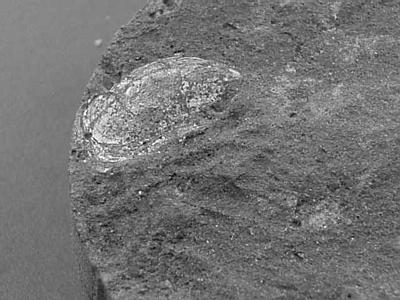
This is the 34,000,000 year old macrofossil of a mussel identified in the core by Dr. Marco Taviani. <<781_mussel.jpg>> Photo by Marco Taviani
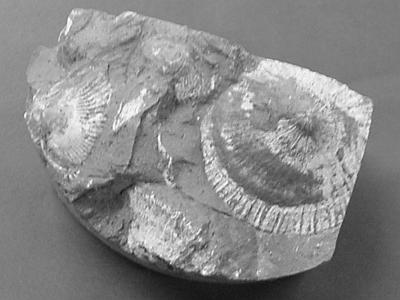
This is a specimen of coral dating back 34,000,000years. <> Photo by Marco Taviani
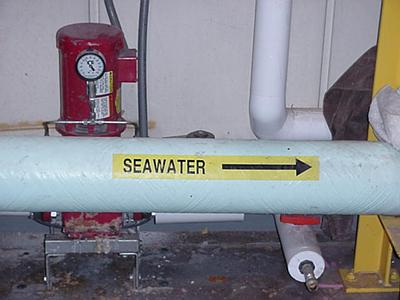
Sea water inlet to the desalination plant. <> Photo by Peter M. Amati, Jr.
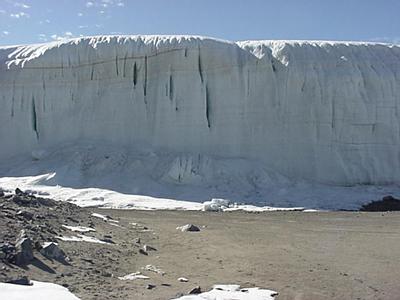
Here is a picture of myself and Wendy standing in front of one of the storage tanks at the desalination plant. <> Photo by Barb Schulz
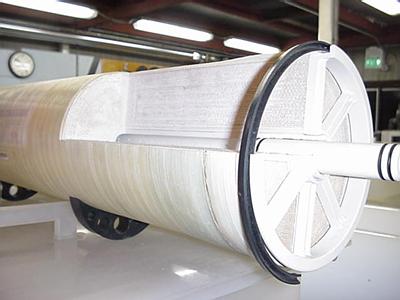
This is a cross section through one of the semipermeable membrane filters . There are six tubes, each containing four of these filters. The "fresh" water collects in the center and is then collected and further processed. <> Photo by Peter M. Amati, Jr.
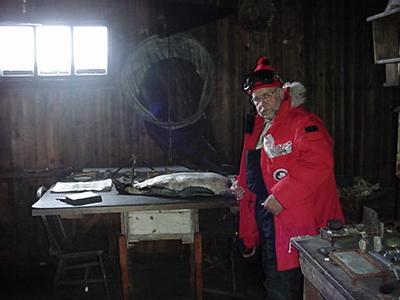
This is a picture of a pressure gauge. It is pressure that allows the process of reverse osmosis to occur. The gauge here reads 680 PSI, that's on its way down from 800 PSI. Keep in mind that normal air pressure is roughly 14.7 PSI. Wow! Talk about pressure. <> Photo by Peter M. Amati, jr.

Here I am standing in front of one of six huge Caterpillar generators that will change fuel oil into electrical energy. There is much energy lost here as heat, but the addition of heat exchangers in this building and eventually throughout McMurdo Station will result in a tremendous energy and cost savings. These heat exchanges basically pass glycol in tubes around the various pipes so that the heat is transferred to the glycol (it has a fairly high specific heat) and then it issued to heat other areas. The projected savings is 460,000 gallons of fuel per year which translates into a savings of some $600,00.00 per year. <> Photo by Chris McMaster
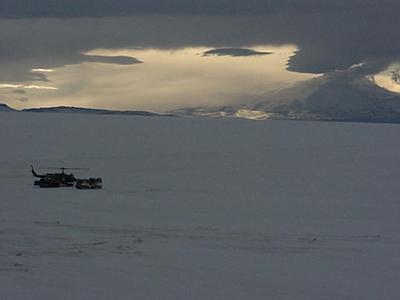
Here is the scene that I saw as I exited the water plant. The clouds are what initially caught my eye, but the commotion in the fore ground involving the helicopter and bulldozer soon became my focus. <> Photo by Peter M. Amati, Jr.
Contact the TEA in the field at
.
If you cannot connect through your browser, copy the
TEA's e-mail address in the "To:" line of
your favorite e-mail package.
|
